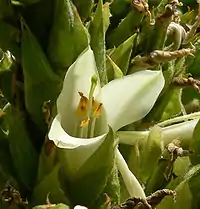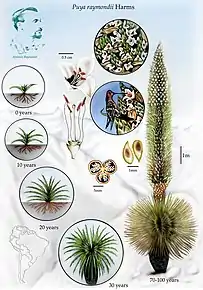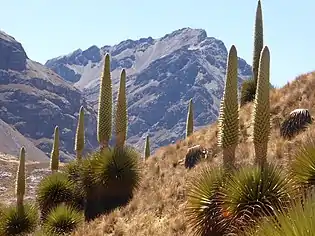Puya raimondii
Puya raimondii, also known as queen of the Andes (English),[1][2] titanka and ilakuash (Quechua)[3] or puya de Raimondi (Spanish),[1] is the largest species of bromeliad, its inflorescences reaching up to 15 m (50 ft) in height. It is native to the high Andes of Bolivia and Peru.[1] It was once hypothesized to be a Protocarnivorous plant.
| Queen of the Andes | |
|---|---|
 | |
| Puya raimondii flowering in Ayacucho, Peru. | |
| Scientific classification | |
| Kingdom: | Plantae |
| Clade: | Tracheophytes |
| Clade: | Angiosperms |
| Clade: | Monocots |
| Clade: | Commelinids |
| Order: | Poales |
| Family: | Bromeliaceae |
| Genus: | Puya |
| Species: | P. raimondii |
| Binomial name | |
| Puya raimondii | |
| Synonyms | |
|
Pourretia gigantea Raimondi | |
Taxonomy
The first scientific description of this species was made in 1830 by the French scientist Alcide d'Orbigny after he encountered it in the region of Vacas, Cochabamba, in Bolivia at an altitude of 3,960 m (12,990 ft). However, as the plants he saw were immature and not yet flowering, he could not classify them taxonomically.[4]
The species name of raimondii commemorates the 19th-century Italian scientist Antonio Raimondi, who immigrated to Peru and made extensive botanical expeditions there. He encountered this species in the region of Chavín de Huantar and published it as new to science under the name Pourretia gigantea in his 1874 book El Perú[5][6] In 1928, the name was changed to Puya raimondii by the German botanist Hermann Harms, as the combination Puya gigantea was already used for a Chilean species.[5]
Description
The queen of the Andes is the largest species of bromeliad.[7] Its trunk can be 5 m (16 ft) tall, with a rosette of about two hundred linear leaves, these up to 1.25 m (4 ft) long and about 8 cm (3 in) in width, the leaf spines reaching 1 cm (3⁄8 in) long.[8] The inflorescence can measure between 4–8 m (13–26 ft) tall.[8][9][7] The whole plant may reach as much as 15 m (50 ft) tall.[9] A single plant can produce between 8,000 [6] and 20,000 [10] flowers in a 3-month period.[7]
Its reproductive cycle (and life) lasts approximately 80 years,[1] though one individual planted near sea level at the University of California Botanical Garden, bloomed in August 1986 after only 28 years.[2] It is semelparous, dying after first reproduction.
The plant has been identified to form a close relationship with pollinating birds, and was even hypothesized to be a protocarnivorous plant due to its abilities to ensnare birds in the spiny fronds.[11] However, the adaptations seen in Puya that lead to ensnarement of birds seems most likely to be instead a defense mechanism.[12]
 Leaves
Leaves Plant
Plant Inflorescence
Inflorescence Inflorescence closeup
Inflorescence closeup Close-up of flower.
Close-up of flower. Flower dissection
Flower dissection with Italian botanist Luigi Piacenza
with Italian botanist Luigi Piacenza
Distribution and habitat
P. raimondii is native to the Andes of Bolivia and Peru, between 3,000–4,800 m (9,800–15,700 ft) of elevation on shrubby and rocky slopes.[1][8] [13][14] This species seem to be very specialist on site conditions as it prefers to grow in small areas even if the surrounding terrain may seem equally suitable, resulting in a patchy distribution of P. raimondii stands.[1] Moreover, in spite of being a high altitude plant, it has thrived at near sea level in temperate climate.[1][2]

 Habitat in Vacas, Cochabamba, Bolivia.
Habitat in Vacas, Cochabamba, Bolivia. Habitat in Ancash, Peru
Habitat in Ancash, Peru Habitat in Huascarán National Park
Habitat in Huascarán National Park
Conservation status
P. raimondii is considered an endangered species by the IUCN.[1] The main threats to its survival are: human caused fires, climate change and a declining genetic diversity.[1]
References
- Lambe, A. 2009. Puya raimondii. The IUCN Red List of Threatened Species 2009. Downloaded on 9 September 2015.
- "San Francisco Botanical Garden - News - Rare Flower in Bloom at SF Botanical Garden". Sfbotanicalgarden.org. Retrieved 2016-01-18.
- "Bosque de Puyas de Raymondi (Titankayoq o Tikankayoq)". mincetur. Retrieved December 18, 2015. (Spanish)
- Wait, Benjamin A. (1978). "Puya raimondii: Wonder of the Bolivian Andes". Journal of the Bromeliad Society. Bromeliad Society. 28 (5): 200.
- "Bromeliad Society of San Francisco" (PDF). Sfbromeliad.org. Retrieved 6 January 2018.
- Antonio Raimondi, EL PERU (Lima: Imprinta del Estado, 1875) Vol. 1 pp. 295-297.
- "BOTANY.cz » PUYA RAIMONDII Harms – Queen of the Andes, Queen of the Puna". botany.cz. Retrieved 2018-08-08.
- Smith, Lyman B.; Downs, Robert Jack (1986). Pitcairnioideae (Bromeliaceae). Flora Neotropica. New York Botanical Garden. pp. 189–190. ISBN 9780893273033.
- Castillo J., Salazar; Fatima, Caceres; Ignazio, Poma (2012). "Puya raimondii the queen of de Andes. Puya raimondii la regina delle Ande". CACTUS & Co. XV: 28–51. ISSN 1129-4299.
- Anthony Huxley, PLANT AND PLANET (New York: Viking 1974) p. 143.
- Rees, W. E., & Roe, N. A. (1980). "Puya raimondii (Pitcairnioideae, Bromeliaceae) and birds: an hypothesis on nutrient relationships". Canadian Journal of Botany. 58 (11): 1262–1268. doi:10.1139/b80-157.
{{cite journal}}: CS1 maint: multiple names: authors list (link) - Chase, M. W., Christenhusz, M. J., Sanders, D., & Fay, M. F (2009). "Murderous plants: Victorian Gothic, Darwin and modern insights into vegetable carnivory". Botanical Journal of the Linnean Society. 161 (4): 329–356. doi:10.1111/j.1095-8339.2009.01014.x.
{{cite journal}}: CS1 maint: multiple names: authors list (link) - Montesinos-Tubée, D.B. (2012). INVENTARIO Y ESTADO DE CONSERVACIÓN DE PUYA RAIMONDII (BROMELIACEAE) EN EL DEPARTAMENTO DE MOQUEGUA, PERÚ (in Spanish). Chloris Chilensis. p. 9.
- Halle, F.; Oldeman, R. A. A.; Tomlinson, P. B. (2012). Tropical Trees and Forests: An Architectural Analysis. Springer Science & Business Media. p. 104. ISBN 9783642811906.
External links
- Photographs of Puya raimondii. Florida Council of Bromeliad Societies.
